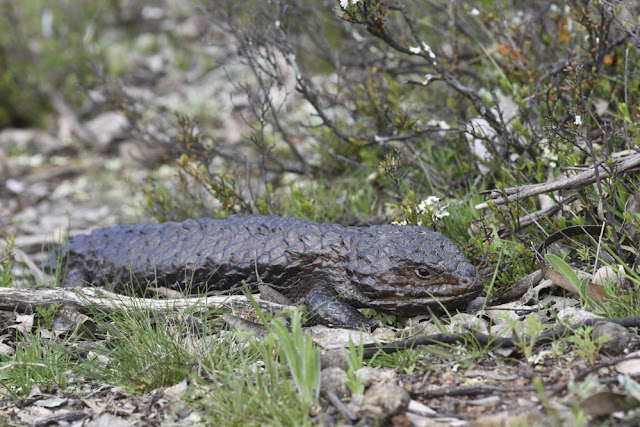 |
| Not the head, but the tail of a Shingleback |
The local reptiles are beginning to show as Spring moves on and the days warm up. There have been rustles in the garden when the little skinks scurried for cover as I passed and I saw my first Shingleback Tiliqua rugosa in the bush a few days ago. These are a species of blue-tongue skink, one of the larger types of lizards in south-east Australia, and as they are slow moving and terrestrial, they need a few tricks for defence from predators.
 |
| A Shingleback out in the open, seen from above - a raptor's eye view. Which is the head end? |
Their main adaptation for protection from predators is deception by camouflage. They are a simple long brown, grey shape that mimics a stick or small broken branch lying on ground. This probablly hides them from aerial predators such as, in our area, Little and Wedge-tailed Eagles. Then if a predator ventures closer, it might be tricked into attacking the tail rather than the head end of the Shingleback because the tail mimics the form of the head. The skink's next strategy when touched is to turn itself around into a tight U-shape, open its mouth wide open, and thrust out its large blue tongue - a shock or startle defence. Blue is such an unusual colour in animals, that it probably has a particularly high startle effect. However, this startle is mostly bluff as the Shingleback has little else to defend itself. They are mostly vegetarian, with a fondness for soft flowers, so they do not have large or sharp teeth or claws.
 |
| When seen from ground level, the eyes make the head more obvious |
I would like to see their defence in action against a predator, although at the same time would rather not as I like shinglebacks and would not like to see one hurt. They are such quiet non-aggressive animals. Perhaps the evidence of me seeing them quite frequently when out in the bush is enough to prove their defence's efficiency.
 |
| Shinglebacks are quiet and easily overlooked, but their slow lifestyle makes them easy prey for their main predators, which these days are the introduced fox and domestic cat |
See the previous posts on shinglebacks listed on the right for more information on them, including a shot of that blue tongue.

No comments:
Post a Comment